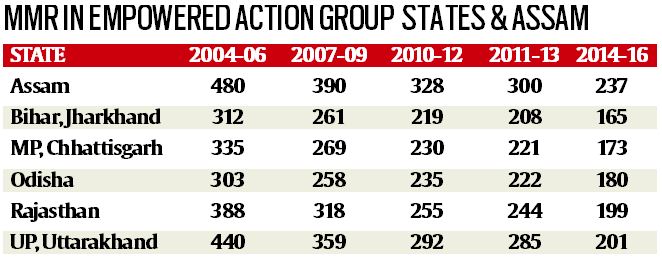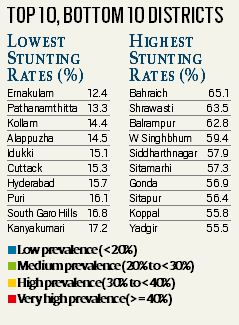Paper-2 : Issues relating to development & management of Social Sector/Services relating to Health, Education, Human Resources
Maternal Mortality Ratio Drops
 What is Maternal Mortality Ratio
What is Maternal Mortality Ratio
- Maternal mortality is defined as the death of a woman while pregnant or within 42 days of termination of pregnancy, irrespective of the duration and site of the pregnancy, from any cause related to or aggravated by the pregnancy or its management but not from accidental or incidental causes.
- Complications during pregnancy and childbirth are a leading cause of death and disability among women of reproductive age in developing countries.
Drop in MMR
- The latest Sample Registration System (SRS) data indicating the Maternal Mortality Ratio (MMR) has brought glad tidings.
- As per the data, MMR, (number of maternal deaths per 1,00,000 live births) has dropped from 167 in (2011-2013, the last SRS period) to 130 for the country.
- This 28% drop is an achievement arising from painstakingly reducing the MMR in each of the States.
- The decline has been most significant in Empowered Action Group (EAG) states — Bihar, Jharkhand, Madhya Pradesh, Chhattisgarh, Odisha, Rajasthan, Uttar Pradesh and Uttarakhand — and Assam, from 246 to 188. Among the southern states, the decline has been from 93 to 77 and in the other states from 115 to 93.
The Way Forward
- India has bettered the MDG target of 139 for 2014-2016.
- This is the outcome of systematic work undertaken by the Centre and States under the NHM that has resulted in saving 12,000 more lives in 2015.
- Three States have already achieved the UN’s Sustainable Development Goal of MMR 70.
- Still fresh impetus is required to bring the MMR below 30 for all States except EAG, which might strive to bring it down to 12-140
Lower socio-economic inequality key to reducing malnutrition
- A study by the Washington-based agri think tank International Food Policy Research Institute (IFPRI) has argued for a change in India’s approach to its malnutrition problem — by going beyond the current focus on health and stressing district-by-district reduction of socio-economic inequality and especially, gender inequality
- The study has analyzed and spatially mapped data from the National Family Health Survey 4 (NFHS 2015-16) on India’s high childhood stunting prevalence of 38.4%, and concluded that very high-stunting districts could eliminate 71% of the gap with low-stunting districts if they are able to improve on specific issues of gender and inequality.
- More than two-thirds of India’s 640 districts, mainly in north and central India, have high to very high levels of stunting: 202 districts have a stunting prevalence of 30%-40%; in 239 districts, levels are above 40%.
Way forward
- Only focusing on health- and nutrition-related factors under the existing ICDS scheme isn’t enough; there is need to address gender-related inequalities at the district level so as to reduce stunting.
- Factors concerning women across their life cycles, such as their education, nutrition, age at marriage, care during and after pregnancy, play a significant role, as do the overall socio-economic status of the household ,so government needs to have framework related to women overall development.
Paper 2: Indian Constitution ,Significant provisions and basic structure
Nagaraj Judgment
Background of Nagaraj
- Responding to the government’s complaint that promotions were at a “standstill” because of verdicts by the High Courts of Delhi, Bombay, and Punjab & Haryana, the Supreme Court said the government was “not debarred” from making promotions so long as they were “in accordance with the law”
- While the court did not specify which law it was referring to, the law that currently applies is the one laid down by the five-judge Bench of Chief Justice of India M Nagaraj & Others vs Union Of India & Others, 2006
- The court dealt with a challenge to constitutional amendments aimed at nullifying the impact of judgments including that in the famous Mandal case, on reservations in promotions for Scheduled Caste and Scheduled Tribe employees
Questions before Supreme Court
The petition challenged the constitutional validity of:
- The Constitution (Seventy-Seventh Amendment) Act, 1995, which inserted Clause 4A in Article 16 (equality of opportunity in matters of public employment);
- The Constitution (Eighty-First Amendment) Act, 2000, which inserted Clause 4B in Article 16;
- The Constitution (Eighty-Second Amendment) Act, 2000, which inserted a proviso to Article 335 (claims of SCs and STs to services and posts); and
- The Constitution (Eighty-Fifth Amendment) Act, 2001, which changed the wording of Article 16(4A).
Indra Sawhney and Others vs Union of India and Others (Mandal case)
- In these cases, the Supreme Court observed that reservation under Article 16(4) — which allows the state to make provisions for “reservation of appointments or posts in favour of any backward class of citizens” — did not apply to promotions.
- This affected SC and ST employees, and in order to ensure that reservations in promotions continued, Clause 4A was introduced: “Nothing in this article shall prevent the State from making any provision for reservation in matters of promotion… in favour of the SCs and the STs which, in the opinion of the State, are not adequately represented in the services under the State.”
- Clause 4B was inserted to ensure that while calculating the quota for a particular year — capped at 50% by Indra Sawhney — the unfilled or ‘carried forward’ quota from the earlier year was not clubbed with the regular quota of that year.
Qualification and Seniority
- The 82nd Amendment Act noted that the Supreme Court had, in both cases ruled that relaxation of qualifying marks and standards of evaluation for reservation in the promotion were not permissible under Article 16(4) in view of the command contained in Article 335.
- To restore the relaxations, the 82nd Amendment added a proviso to Article 335, allowing “relaxation in qualifying marks in any examination or lowering the standards of evaluation, for reservation in matters of promotion to any class or classes of services or posts in connection with the affairs of the Union or of a State”.
- The 85th Amendment noted that the SC judgments had affected the interests of SC/ST employees “in the matter of seniority on promotion to the next higher grade”.
- The amendment introduced the words “with consequential seniority” after “in matters of promotion” in Article 16(4A).
The Nagaraj judgment
- The petitioners argued that the four amendments were aimed at reversing the judgments in Indra Sawhney and other cases, that Parliament had arrogated to itself judicial powers, and had, therefore, violated the basic structure of the Constitution.
- The court upheld the constitutional validity of the 77th, 81st, 82nd, and 85th Amendments.
- It, however, ruled that if the state wished to exercise their discretion and make a provision for reservation in promotions for SCs/STs, the State has to collect quantifiable data showing backwardness of the class and inadequacy of representation of that class in public employment in addition to compliance of Article 335
- Also, even if the State has a compelling reason it will have to see that its reservation provision does not breach the ceiling-limit of 50% or obliterate the creamy layer or extend the reservation indefinitely.
Who is a citizen
Why in News
- The exercise to update the six-and-a-half-decade-old National Register of Citizens (NRC), the second draft of which is due to be out by the end of this month, and a controversial amendment proposed to the Citizenship Act, 1955, that seeks to selectively regularize some categories of illegal migration, have triggered a fresh wave of anxiety and unrest around these issues.
Who is a citizen in India’s constitutional scheme?
- Citizenship defines the relationship of an individual with a political community, and signifies the individual’s full and equal membership of that community. A citizen is defined in opposition to an ‘alien’; the exclusion of aliens is central to the concept of modern citizenship
- Article 5 provided for citizenship on the commencement of the Constitution: all those domiciled and born in India, either of whose parents was born in India, or anyone who had been ordinarily resident in India for at least five years preceding the commencement of the Constitution. Under Article 6, anyone who migrated to India before July 19, 1948, from territory that had become part Pakistan, automatically became a citizen if either of their parents or grandparents was born in India
- Those who had migrated to Pakistan after March 1, 1947, but had subsequently returned on resettlement permits, too, were included within the citizenship net (Article7). Under Article 8, a person of Indian origin residing outside India who, or any of whose parents or grandparents, was born in India can register as an Indian citizen with the relevant Indian diplomatic mission.
How did the situation in Assam impact the nature of citizenship?
- To protect the social and cultural interests of the Assamese people, Parliament enacted The Immigrants (Expulsion from Assam) Act in 1950, under which the central government could order the removal of any person who had come into Assam from outside India, and whose “stay… in Assam is detrimental to the interests of the general public of India or of any section thereof or of any Scheduled Tribe in Assam”.
- However, the aftermath of the Partition of India, including the failure of the two-nation theory that was manifested in the birth of Bangladesh, and the nature of the topography and porous border in the east, saw continued large scale infiltration into Assam — which triggered an agitation in the state that ultimately led to the signing of the Assam Accord of August 15, 1985.
- The 1986 amendment made the Citizenship Act less inclusive, by adding to the principle of jus soli(right of the soil) the condition that in addition to one’s birth in India (for those born on or after July 1, 1987), at least one parent must be be an Indian citizen at the time of birth.
- The 2003 took it closer towards jus sanguinis (right of blood) and away from jus soli— for those born after the commencement of the Act, not only was at least one parent required to be an Indian citizen, the other could not be an illegal migrant.
What is the new proposed amendment to the Citizenship Act?
- The Citizenship (Amendment) Bill, 2016, seeks to amend the 1955 Act to permit members of six communities — Hindu, Sikh, Buddhist, Jain, Parsi and Christian — from Pakistan, Bangladesh and Afghanistan eligible for citizenship if they had entered the country before December 14, 2014. Under the original Act, an applicant seeking citizenship by naturalization must have resided in India during the last 12 months, and for 11 of the previous 14 years. The proposed Bill relaxes the 11-year requirement to six years for applicants belonging to these six religious communities and three countries.
Paper 3: Effects of liberalization on the economy, changes in industrial policy and their effects on industrial growth.
Panel for SEZ Policy
Why in news?
- US has been consistently dragging India at WTO against various subsidies offered by it.Commerce ministry sets up panel to make SEZ policy compatible with WTO rules The panel so set is a small move to put forth India’s genuine interests protecting its domestic exporters
India’s SEZ Policy
- The Special Economic Zones Act, 2005, was passed by Parliament in May, 2005 and came effect in 2006.THe main objectives of having SEZ policy is to generate additional economic activity,promote exports of goods and services,promote investment from domestic and foreign sources,create employment opportunities and to develop infrastructure facilities
- The functioning of the SEZs is governed by a three tier administrative set up. The Board of Approval is the apex body and is headed by the Secretary, Department of Commerce.
US Challenge
- The US on 14 March challenged almost India’s entire export subsidy regime in the WTO including ,merchandise exports from India scheme, export oriented units scheme and sector specific schemes,,including electronics hardware technology parks scheme;special economic zones; export promotion capital goods scheme and Duty-free imports programme for exporters.
- There were consultations but the matter was failed.
Panel for SEZ
- The commerce ministry has set up a committee headed by Bharat Forge chairman Baba Kalyani to make its special economic zone (SEZ) policy compatible with WTO rules after the US challenged India’s export subsidy programme at the multilateral trade body.
- The commerce ministry has been consistently lobbying with the finance ministry to exempt units in the SEZs from the minimum alternate tax, or MAT, imposed on them in 2011.



